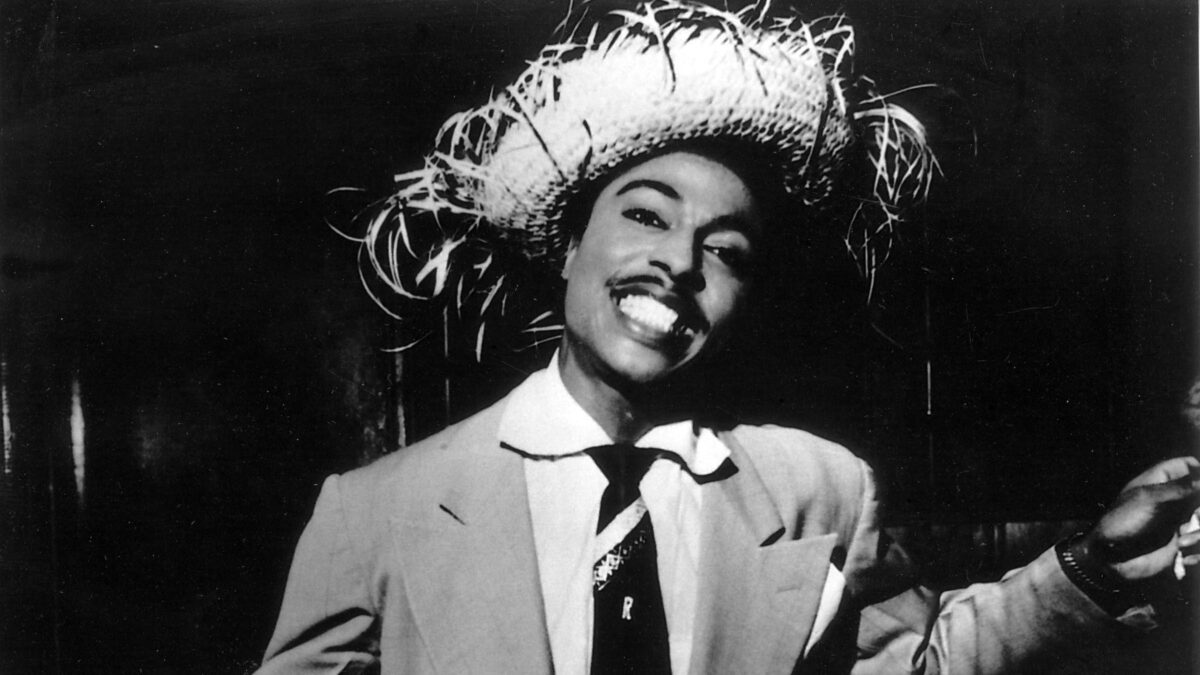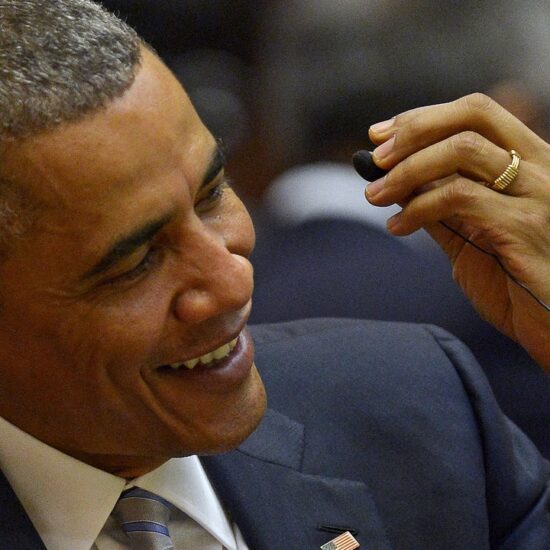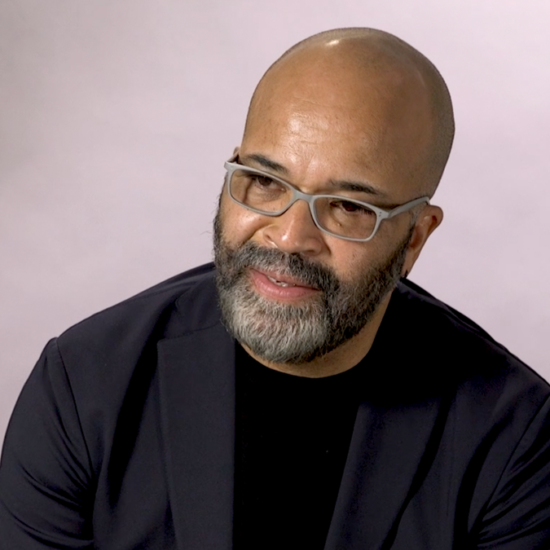
Throughout the years, Little Richard has been referred to as the king, queen, architect, quasar and founder of rock ‘n’ roll.
While experiencing racism, homophobia, industry exploitation and struggling with his faith, Little Richard still managed to create music and an overall style that have become fundamental elements of Western pop culture.
This article explores the music that influenced him and the hit songs that made him a legend.
1. “Strange Things Happening Every Day” by Sister Rosetta Tharpe
In order to fully characterize Little Richard’s legacy, we must first understand his influences.
Little Richard was born Richard Wayne Penniman in Macon, Georgia. He was raised in a Black Pentecostal household, growing up around gospel music. It’s in this sonic atmosphere that Little Richard grew to admire and look up to the singing evangelist Brother Joe May, where he honed his signature whoop while listening to the Clara Ward Singers and where he learned the descant-like vocalizations of Mahlia Jackson. Perhaps most importantly, its where he first became interested in the mélange of spiritual songs and swinging secular sounds pioneered by Sister Rosetta Tharpe as can be heard in her rendition of “Strange Things Happening Every Day,” which in 1945 was the first gospel song to be placed on the R&B charts (then called “race” charts).
Tharpe’s influence on Richard goes beyond her unique style. She gave 14-year old Penniman his first paying gig as her opener in Macon after hearing him singing backstage. At the time, Little Richard likely didn’t know that Tharpe took same-sex lovers or that her music was often intended to rebel against the strictures placed upon women within the church, however, that nonconforming spirit is something Little Richard incorporated into his life, career and legacy.
2. Esquerita and “One Mint Julep” by The Clovers
After his father threw him out of his home for his flamboyance at the age of 14, Little Richard joined the Chitlin’ Circuit – a traveling group of performers who performed at Black (and often queer) nightclubs around the American South. It’s here where he met Esquerita, a six foot two Black queer performer with a towering pompadour and bedazzled clothing (sound familiar?). Not only did Esquerita inform much of Richard’s fashion, he also informed his piano technique. On the night they met, Esquerita played Richard “One Mint Julep” by the Clovers. Richard recalled that “[Esquerita] was one of the greatest pianists, and that’s including Jerry Lee Lewis, Stevie Wonder or anybody I’ve ever heard…” After that night Little Richard asked Esquerita to teach him everything he knew about playing piano. Richard was later quoted saying, “I learned a whole lot about phrasing from him. He really taught me a lot.”
3. Tutti Frutti
After cutting his teeth on the Chitlin’ Circuit for several years, Little Richard yearned for a larger stage. By sheer force of persistence, in 1955 he was offered a recording session with Specialty Records in New Orleans. After recording some blues standards, everyone in the room (including Richard) was a bit dubious of the trajectory of the session. However, during their lunch break, Little Richard got on the stage of the nearby Dew Drop Inn and sung the original version of “Tutti Frutti.” The lyrics included explicit references to anal sex:
Tutti Frutti, good booty
If it don’t fit, don’t force it
You can grease it, make it easy
The Specialty Records producers in the audience immediately recognized the potential of the song’s hook and rhythm. They exchanged the references to “good booty” and lubrication for the common colloquialism “aw rooty” and a hit was born!
In a panel discussion about Little Richard’s influence, Jason King describes Richard’s groundbreaking sound, “He updated Fats Domino’s cool New Orleans R&B, and he gave you boogie-woogie bass shuffle in his left hand piano playing. And on the right hand, he gave you hard-driving, percussive, eighth-note octaves—a sort of ‘pounding’ on the keys. And those two things together helped create a unique sound. Add to that his gritty gospel voice, and you have the recipe for a heart-shaking, rib-quaking, high-voltage rock ‘n’ roll. It literally made you rock.”
3. Long Tall Sally
The success of “Tutti Frutti” was tainted when it was almost immediately covered by the white pop singer, Pat Boone, whose version of the song garnered many more record sales than Richard’s. Richard commented on the racism that allowed this to happen by saying “the white kids would have Pat Boone up on the dresser and me in the drawer ’cause they liked my version better, but the families didn’t want me because of the image that I was projecting.”
As retaliation, Little Richard’s next single “Long Tall Sally” was much faster in an attempt to be “uncoverable.” Little Richard’s producer at the time, Bumps Blackwell recalls “we decided to up the tempo on the follow-up and get the lyrics going so fast that Boone wouldn’t be able to get his mouth together to do it!” But in the words of Pat Boone, “if I could sing ‘Whop-bop-a-loo-bop-a-bop-bop-bop’ I could sure sing ‘Long Tall Sally,’” so he covered the song anyway.
Regardless, “Long Tall Sally” became Richard’s biggest hit and the best-selling record in the history of Specialty Records.
4. The Girl Can’t Help It
In 1956, the animator and comedy writer Frank Tashlan brought the zany physical comedy of the Looney Tunes to the jukebox musical “The Girl Can’t Help It.” The film was an attempt to capture (and satirize) the raising influence of rock ‘n’ roll. Starring Jayne Mansfield in her first major film role, the film is packed with performances from some of rock’s early royalty including Fats Domino, Julie London, Eddie Cochran, the Platters, Gene Vincent and Little Richard who performs the film’s titular song, “The Girl Can’t Help It.”
For many people, including teenaged John Lennon and Paul MacCartney, the film was the first time they were able to see their rock ‘n’ roll icons on screen or otherwise. The Beatles credit the film as being a major influence on their pursuit of rock ‘n’ roll stardom.
Notably, Fergie sampled the hook of the titular song in her 2006 hit, “Clumsy.”
5. Lucille
In a 1999 interview with Mojo magazine, Richard explained: “The effects and rhythms you hear on my songs, I got ’em from the trains that passed by my house. Like ‘Lucille’ came from a train – Dadas-dada-dada-dada, I got that from the train.” Released in 1957 when Little Richard’s popularity was reaching an all-time high, “Lucille” was his fourth million selling record.
While at this point Richard had already laid the groundwork for rock ‘n’ roll with his percussive piano playing on songs like “Tutti Frutti” and “Long Tall Sally,” the rhythm of “Lucille” that Richard credits to the train foreshadowed the heavy baselines and slower tempos characteristic of 1960s rock music.
6. Good Golly Miss Molly
Released in 1958, like much of Richard’s early music, “Good Golly Miss Molly” is a rock ‘n’ roll standard and has been covered hundreds of times. In the early-1950s, when Richard performed live, he often performed to a segregated audience. However, the infectious nature of the music paired with his effeminate persona, helped to break down these barriers. Producer H.B. Barnum told Richard’s biographer, Charles White, that “Little Richard brought the races together. Although they still had the audiences segregated in the building… by the end of the night they would all be mixed together.”
Richard continued fighting for civil rights more formally later in his career when he would advocate for artists of color who’d been taken advantage of by their record companies – seeking royalties and industry reparations.
7. It Takes Everything to Serve the Lord
In October 1957, the Russian satellite Sputnik returned to Earth’s atmosphere leaving a bright streak across the sky. While performing in Sydney, Australia Little Richard saw this phenomenon and interpreted it not as one of Man’s latest trifles, but as an omen from God directed at him specifically. The message was that rock ‘n’ roll and homosexuality were sins and Richard needed to repent to secure his immortal soul a place in the Kingdom of Heaven. After this event, Richard gave up rock ‘n’ roll and his wild ways to pursue a life as a pastor and gospel singer. He didn’t, however, give up his trademarked confidence, releasing an album entitled “The King of the Gospel Singers,” which included Richard’s rendition of “It Takes Everything to Serve the Lord.”
8. Great Gosh A’Mighty
One of the more complicated aspects of Little Richard’s legacy is his relationship with Christianity. For the remainder of his career, Little Richard would adopt and renounce rock ‘n’ roll music in favor of his faith several more times. However, after the success of his biography “Quasar of Rock: The Life and Times of Little Richard” (1985), Richard decided he could unite the seemingly disparate influences of his life by creating faith-based rock music. “Great Gosh A’ Mighty” was his attempt to do exactly that. The song has the bumping rhythm of a classic Little Richard track, however, upon closer inspection of the lyrics, the song is unmistakably religious.
From his flamboyance, camp and unapologetic self-expression to his bumping rhythms and baselines, Richard’s influences can be seen in almost every modern performer.
You can see Little Richard’s influence in Prince’s “Kiss,” David Bowie’s “Let’s Dance” and even Lil Nas X’s “HOLIDAY.” All of these musicians and more have Little Richard to thank for opening doors and creating an art form.
For more music from Little Richard and others, check out the official soundtrack to American Masters – Little Richard: The King and Queen of Rock and Roll.













